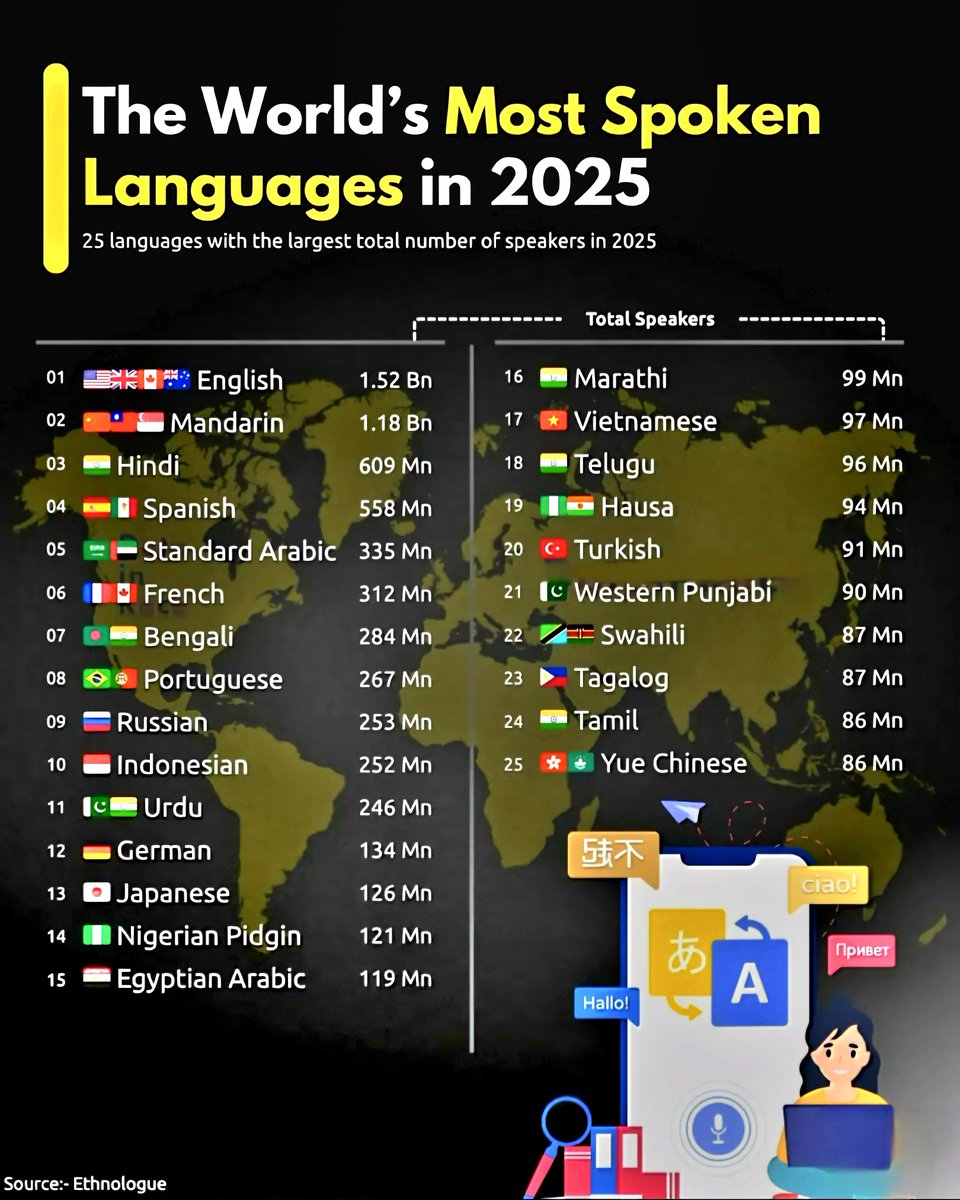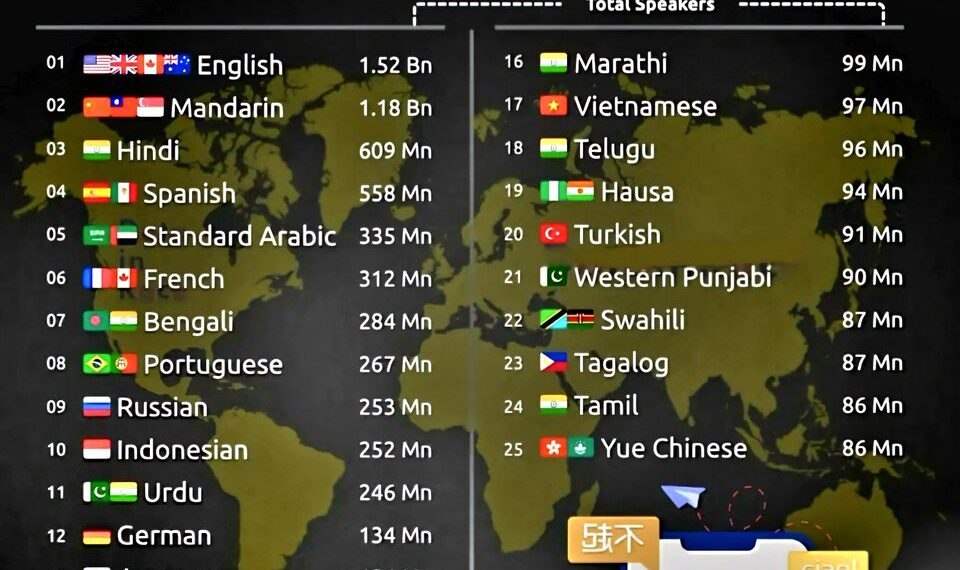Select Language:

The 25 Most Spoken Languages in 2025: A Global Perspective
As the world becomes more interconnected, understanding the languages spoken across the globe is essential. In 2025, the landscape of linguistic dominance continues to evolve, reflecting demographic shifts, technological advancements, and cultural exchanges. Here are the top 25 most spoken languages around the world today.
1. Mandarin Chinese: The Global Language Leader
Mandarin maintains its position as the most spoken language globally, with over 1.2 billion native speakers. China’s economic rise has catalyzed the language’s popularity internationally, making it essential for business and diplomacy. Its tonal complexity and rich history make Mandarin a fascinating language to learn, especially for global professionals.
2. Spanish: The Language of the Americas and Beyond
With approximately 560 million speakers, Spanish remains a vibrant and widespread language. Its influence extends across Latin America, Spain, and increasingly in the United States, where Hispanic communities continue to grow. Spanish’s cultural depth, from music to cuisine, fuels its global popularity.
3. English: The Lingua Franca of the Modern World
English continues to dominate as a global lingua franca, spoken by over 1 billion people including those who speak it as a second language. Its role in international business, technology, science, and entertainment cements its universal appeal, especially in countries across Africa, Asia, and Europe.
4. Hindi: India’s Growing Voice
With nearly 600 million speakers, primarily in India, Hindi’s prominence is higher than ever. As India cements its position as an economic and technological powerhouse, the global interest in Hindi is surging, with more people learning it for both cultural and business purposes.
5. Arabic: The Language of the Middle East and North Africa
Arabic, with around 400 million native speakers, continues to be significant culturally and strategically. Its various dialects are rich in history and religion, fostering a deep connection with the Arab world and beyond, bolstered by ongoing geopolitical developments.
6. French: The Language of Diplomacy and Culture
Beyond France, French is spoken across Africa, the Caribbean, and parts of Southeast Asia, totaling about 300 million speakers. Its role in international organizations like the UN and its cultural influence keep French relevant in diplomatic and artistic spheres alike.
7. Bengali: A Rising Power in South Asia
Boasting over 300 million speakers, Bengali is primarily spoken in Bangladesh and the Indian state of West Bengal. Its cultural exports—literature, film, and music—are gaining international recognition, fueling interest among language learners worldwide.
8. Portuguese: The Language of Grace and Growth
With approximately 280 million speakers, Portuguese continues to expand, driven by Brazil’s economic development and Portugal’s global outreach. It remains vital in trade, diplomacy, and cultural exchange across lusophone nations.
9. Russian: The Arctic and Eurasian Stakeholder
Russian has roughly 260 million speakers. Its strategic importance in Eurasia and scientific research, particularly in Arctic exploration, maintains its global relevance, alongside a rich literary and artistic heritage.
10. Japanese: The Language of Innovation
Home to nearly 125 million speakers, Japan’s technological prowess keeps its language prominent. Learning Japanese opens doors to a vibrant entertainment industry, advanced technology, and international business opportunities.
11. Punjabi: The Cultural Heartbeat of South Asia
With more than 125 million speakers, primarily in India and Pakistan, Punjabi’s rich musical and cultural traditions continue to flourish, garnering international interest in language and cultural exchange.
12. Wu Chinese (Shanghainese): China’s Economic Powerhouse
Numerous speakers of Wu Chinese, especially in Shanghai and surrounding regions, contribute to its prominence. As China’s economic influence grows, greater numbers are learning regional Chinese dialects.
13. Javanese: The Language of Indonesia’s Heart
Indonesia’s vast population includes around 82 million Javanese speakers, making it one of the most spoken regional languages. Its cultural significance is reflected through music, dance, and tradition.
14. Marathi: Maharashtra’s Voice
With over 83 million speakers, Marathi is a critical language within India’s thriving Marathi culture and has gained prominence as Indian states expand economically and culturally.
15. Telugu: South India’s Expression
Approximately 81 million speakers in India’s Andhra Pradesh and Telangana states make Telugu a key regional language growing in influence in technology and education sectors.
16. Turkish: Connecting Eurasia
Spoken by approximately 75 million people, Turkish serves as a bridge between Europe and Asia, with ongoing reforms and cultural initiatives elevating its global stature.
17. Korean: A Cultural and Technological Force
Korean continues to attract global attention due to the Korean Wave—K-pop, cinema, and technology—that garners millions of fans worldwide, totaling roughly 77 million speakers.
18. Vietnamese: Southeast Asia’s Rapidly Growing Language
Vietnamese, with around 76 million speakers, is expanding its influence. Vietnam’s booming economy and dynamic cultural exports contribute to rising global interest.
19. Urdu: Pakistan’s Language of Literature and Connection
With approximately 66 million speakers, Urdu holds cultural and political significance, particularly in Pakistan, India, and among diaspora communities.
20. Hausa: Africa’s West African Voice
Hausa is spoken by over 52 million across West Africa, serving as a lingua franca for trade, communication, and cultural exchanges in the region.
21. Swahili: Africa’s Common Thread
Swahili’s role as a cross-border language in East Africa has grown significantly, with around 70 million speakers and increased importance in regional business and diplomacy.
22. Thai: Southeast Asia’s Cultural Anchor
Spoken by about 60 million, Thai continues to be central to Thailand’s culture and tourism sectors, attracting language learners and expatriates worldwide.
23. Farsi (Persian): Iran and Beyond
With over 52 million speakers, Farsi remains a key language for Iran, Afghanistan, and parts of Central Asia, with cultural and historical significance.
24. Polish: Central Europe’s Stable Presence
Polish, spoken by around 45 million, remains influential in European politics, culture, and diaspora communities across the U.S. and Canada.
25. Italian: The Romance Language of Art and Culture
Italians number approximately 67 million, with the language at the heart of global art, culinary, and fashion industries, maintaining Italy’s cultural allure worldwide.
The shifting dynamics of language influence underscore the importance of linguistic diversity in today’s world. As demographic and economic trends evolve, these languages will continue shaping global communications, cultures, and business environments into 2025 and beyond.







